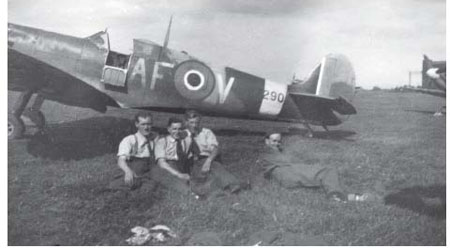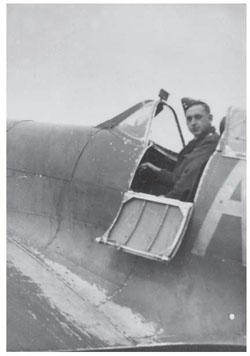Read A Very Unusual Air War Online
Authors: Gill Griffin
A Very Unusual Air War (20 page)
1 June
: Third flight. Two aircraft were involved in this type of trial, one acting as target, the other carrying out mock attacks, probably to test either an improved type of film or new camera.
2 June
: No conversion course for the Skua. I do not remember any instructions at all, just get in and fly the thing. The Skua was a hopelessly obsolete aircraft that started out as a Fleet Air Arm ship-borne fighter but was quickly overshadowed and replaced by better machines. L 2994 arrived at Duxford, complete with LAC Ainslie who was trained in the use of drogue targets for air-firing practice. We flew to Matlas, somewhere on the east coast, and had the winch-towing equipment installed in the rear cockpit. In flight, the drogue, a canvas sleeve rather like a large windsock, could be streamed way out at the rear of the towing aircraft. It then became the target for the trainee fighter pilots. I was always concerned that they would hit the towing aircraft rather than the drogue but as we did not have a successful exercise, I never did find out whether it happened.

AFDU ground crew with Spitfire P7290, Mk 2.



Tadeusz ‘Teddy’ Kulczyk and Len with Mustang 1, Duxford, 1942.
These exercises were carried out off the east coast, just off Lowestoft; they were all unsatisfactory. On two of the trips the drogue failed to stream and once almost got tangled into the tail-plane. On another effort, the fighter failed to turn up so although they say, ‘If at first you don’t succeed, try, try again,’ three was enough, we gave up and went home. Further trials were postponed until June 18th.
4 June
: When carrying out fighter affiliation exercises I was, on several occasions, invited to fly in a Lancaster. I was invited by the pilot to make this flight and it is entered in my logbook as ‘passenger’ but actually after becoming airborne, I took over the controls from the 2nd pilot’s position to demonstrate corkscrewing. Although I did something similar on later flights it was always as 2nd pilot. What a delightful aeroplane the Lanc was to fly, as easy on the controls as any fighter.
8 June
: First trip. An early morning flight to Desford to visit my old instructors and show off my prowess in a Spitfire. They were pleased to see one of their pupils who had successfully made it on to front-line fighters but green with envy, having to continue as instructors.
During this period we three fighter boys, P/O Walker, P/O Godefroy and I, together with Jock Murray, were officially ‘detached’. This suited us very well as Waddington was one of the pre-war stations with an excellent officers’ mess which had its own pig and poultry farm, so the food was first class. As we were only temporary visitors we paid no mess bills other than drinks at the bar. We generally had time on our hands and put it to good use in the games and snooker rooms. Jock, of course, knew many of the senior officers and arranged for us to spend time at the aircraft dispersals and attend the briefings when operations were taking place.
10 June
: To Reading. Jock Murray had two sessions at AFDU during my service there and was promoted to Squadron Leader in the autumn of 1942. He was in command of the Fighter Affiliation flight and its operations. A tall, slim, raw-boned Scotsman, he started the war, like me, as an NCO pilot, being awarded a DFM for operations on Wellingtons. He was commissioned and went on to be awarded a DFC for another tour of operations, initially on Wimpies, later on Lancasters.
After his spell at AFDU, I believe that Jock went back on operations as one of the ‘Pathfinders’, flying both Lancasters and Mosquitos in that role, and received further awards. His wife sometimes travelled from their home in Scotland to attend ladies’ nights and other social functions. I remember her as a handsome woman, as tall as Jock, and I could picture her leading a band of kilted Scotsmen to fight the Redcoats or members of another clan.
16 June
: Another attempt at target towing; this time it was the weather that beat us, very low cloud and poor visibility over the sea.
17 June
: Fuel consumption. For these tests the aircraft was fitted with a Kent flow-meter, installed by the manufacturers at Luton.
Mustang. This was my first solo on type, no special instructions other than take-off and final approach speed, then get in and fly it. This was a Mustang Mk 1, known to the American Air Force as the P51, which was powered by an Allison engine. Designed essentially for airfield defence, it was turned down by the RAF due to inadequate performance at high altitude.
18 June
: Another wasted trip! We finally gave up and the Skua was returned to whence it came.
19 June
: During this six-month period, the flights titled ‘co-op’ or ‘co-operation’ with various bombers should more correctly be called ‘fighter affiliation’. They were intended to help the bomber boys cope with enemy fighter attacks, day or night. This mainly involved teaching them a manoeuvre called a ‘corkscrew’ to throw the attacker off his aim or merely to avoid being hit by his gunfire.
The trips were relatively short but very tiring. It would appear that we only did one or two exercises per day; this is not so, as only one fighter was involved each time and we fighter boys took it in turn to do the attacking, each in a different machine. On some occasions even Jock would join in; he loved to fly the Spitfires whenever he could.
21 June
: The Seafire was the Fleet Air Arm equivalent to a Spitfire Mk 11, equipped for deck landings on an aircraft carrier, with an arrester hook instead of, or as well as, a tail wheel. In this instance, it would have been flown by a pilot of our sister unit, the NAFDU (Naval Air fighting Development Unit), commanded by Lieutenant Commander Brian Kendal.
The 1426 Flight was formed to fly any enemy aircraft that fell into Allied hands. Originally part of AFDU, they operated as an independent detached unit, although their administration was still looked after by the AFDU headquarters staff. Among others, they flew a Heinkel III, a Messerschmitt 110, a JU88, a Fieseler Storch and an ME 109E. Later, in 1943, a Focke Wulf 190 was also added to their strength. We escorted the Heinkel to Stradishall where we stayed overnight before flying on the next morning to Boscombe Down.
23 June
: In addition to basic instructions, it was thought necessary for me to have further instruction into emergency procedures such as in the event of an engine failure, having to fly and land on one engine. F/Lt Rumble (always known as Tubby) was at that time the AFDU Flight Commander, a very experienced pilot with thousands of flying hours in his logbook.
24 June
: I was wrong in my earlier comment, we had not yet seen the last of the Skua. Our efforts were rewarded – success at last!
Looking back I am surprised that the Skua winch operator was only a Leading Aircraftsman (LAC). Before the war and in the early months, many aircrew below pilot category were corporals or below. This unfair situation was corrected and later all members of aircrew were sergeants and above.
28 June
: The first of the day was a fun flight for two of the lads. Funny; although I was inexperienced on twins, the members of the ground staff never questioned my capability. The flight to White Waltham on the 25th seems a bit peculiar; I assume that
I flew the Oxford there, then left the aircraft to hitch a lift to Slough for the weekend, leaving F/O Poole (usually known as Puddle) to make the return to Duxford.
After I had been at Duxford for two or three weeks, I was again summoned for a talk with the officer commanding AFDU, Wing Commander Campbell-Orde, for some reason always known as ‘the General’. I was informed that he encouraged his married officers to ‘live out’ with their wives. I explained that even married women below a certain age had to do some form of war work and that my wife Estelle was the secretary to the CID department of Slough police force. He suggested that in order to get her released, I should take another week’s leave and get her pregnant. I was quite willing to act on his suggestion and went off to Slough determined to do my best. In the event, I was not put to the test, as the officer in charge at Slough, Superintendent Tucker, was a friend of the family and Estelle was released without any difficulty, on condition that she obtained a job at Duxford. This did not happen as there was no suitable work nearby, so she merely left her name on the register and we fulfilled the Wingco’s original suggestion before she was called upon.
For the first month we had a room at the Duxford village vicarage, a large rambling old house with lots of spare rooms. The vicar was the Rev. Dr. Braham, whose son was Wing Commander John Braham, at that time the top-scoring night fighter pilot. John’s wife Joan and their baby son, Michael, also lived at the vicarage. Also in residence were our polish pilot, Tadeusz Kulczyk and his English wife, Monica. We all became good friends.
Two other temporary residents were the village schoolmistress and her daughter and the aristocratic Mrs. Hastings-Till. One morning the vicar announced that he hoped everyone would attend his church the coming Sunday and I remember Estelle’s whispered comment that the day she attended a service he would fall out of his pulpit. Our quarters were not really ideal but at the time we were glad of them. We were delighted when F/O Peter Poole was posted back to his squadron and we were tipped off that their rooms at College Farm, also in Duxford village, were available if we wished to take them over. It was with great delight that we did so.
Our stay there lasted from the end of June until March 1943, when the ‘Yanks’ took over Duxford. College Farm was owned by Guy and Ynez Smith, a young couple much the same age as ourselves and who had also been married just the previous year. It was a working farm of some 600 acres and included much of the land to the south of the airfield. Guy’s family farmed a large area to the south of Cambridge. Ynez’s father was a director of the Bank of England. We paid the princely sum of £1 per week for our rooms – large bedroom, dressing room, sitting room, kitchen and scullery. As I was frequently away for several days at a time on fighter affiliation exercises, Ynez decided that it was not much fun for Estelle to cook meals just for herself, so she was invited to join Ynez and Guy at mealtimes. I believe there was a nominal extra charge for this but Ynez usually refused to take it. Ynez loved parties and encouraged us to invite other AFDU members and their ladies for evening meals.

